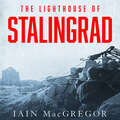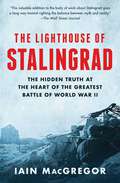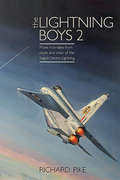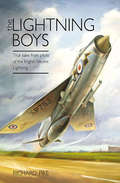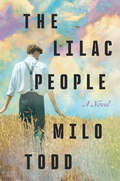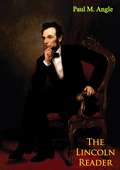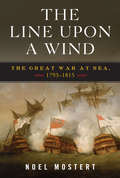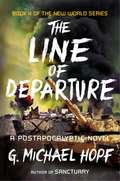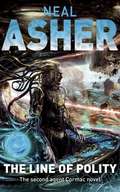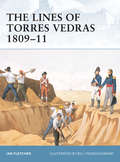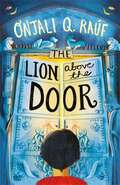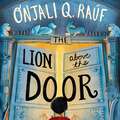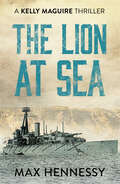- Table View
- List View
The Lighthouse of Stalingrad: The Hidden Truth at the Centre of WWII's Greatest Battle (Karen Pirie #2)
by Iain MacGregor'Stunning. History at its very best: a blend of impeccably researched scholarship, genuinely revelatory primary sources, and a beautifully written narrative.' - James Holland'The sheer brutal intimacy of his descriptions of the fighting are extraordinary.' - Frederick Taylor'A wonderful and important and timely book.' - Alexander Kershaw, New York Times bestselling author of The Bedford Boys and First Wave'An authoritative and unforgettable insight into the decisive days of that most terrible struggle on the banks of the Volga.' - Jonathan Dimbleby'An utterly gripping read.' - James Holland'MacGregor writes with great fluency and narrative drive . . . compellingly terse.' - William Boyd'Magisterial.' - Dan SnowThe sacrifices that enabled the Soviet Union to defeat Nazi Germany in the Great Patriotic War 1941-45 are sacrosanct. The foundation of their eventual victory was laid during the battle for the city of Stalingrad, resting on the banks of the river Volga. For Germany, the catastrophic defeat was the beginning of their eventual demise that would see the Red Army two years later flying their flag of victory above the Reichstag. Stalingrad is seen as the pivotal battle of the Second World War, with over two million civilians and combatants either killed, wounded or captured during the bitter winter of September 1942. Both sides endured terrible conditions in brutal house-to-house fighting reminiscent of the Great War. Within this life-and-death struggle for the heart of the city and situated on the frontline was a key strategic building, codenamed: 'The Lighthouse'. Here, a small garrison of Red Army guardsmen withstood German aerial bombardments and fought off daily assaults of infantry and armour. Red Army newspaper reports at the time would be seized upon by the Moscow media needing to place a positive spin on the fighting that had at one point looked beyond salvation. By the end of the war, the story of this building would gather further momentum to inspire Russians to rebuild their destroyed towns and cities until it became the legend it is today, renamed after the simple sergeant who had supposedly led the defence - 'Pavlov's House'. In time for the eightieth anniversary, The Lighthouse of Stalingrad will shed fresh insight on this iconic battle through the prism of the men who fought one another over five months and the officers who commanded them. A riveting narrative, informed by both German and Russian archives to unearth unpublished memoirs and eyewitness testimonies from veterans and civilians alike, this book will celebrate the real heroes and provide a truer picture of how this mighty battle finally ended.
The Lighthouse of Stalingrad: The Hidden Truth at the Heart of the Greatest Battle of World War II
by Iain MacGregorA thrilling, vivid, and &“compelling&” (Wall Street Journal) account of the epic siege during one of World War II&’s most important battles, told by the brilliant British editor-turned-historian and author of Checkpoint Charlie.To the Soviet Union, the sacrifices that enabled the country to defeat Nazi Germany in World War II were sacrosanct. The foundation of the Soviets&’ hard-won victory was laid during the battle for the city of Stalingrad, resting on the banks of the Volga River. To Russians, it is a pivotal landmark of their nation&’s losses, with more than two million civilians and combatants either killed, wounded, or captured during the bitter fighting from September 1942 to February 1943. Both sides endured terrible conditions in brutal, relentless house-to-house fighting. Within this life-and-death struggle, Soviet war correspondents lauded the fight for a key strategic building in the heart of the city, &“Pavlov&’s House,&” which was situated on the frontline and codenamed &“The Lighthouse.&” The legend grew of a small garrison of Russian soldiers from the 13th Guards Rifle Division holding out against the Germans of the Sixth Army, which had battled its way to the very center of Stalingrad. A report about the battle in a local Red Army newspaper would soon grow and be repeated on Moscow radio and in countless national newspapers. By the end of the war, the legend would gather further momentum and inspire Russians to rebuild their destroyed towns and cities. This story has become a pillar of the Stalingrad legend and one that can now be told accurately. Written with &“impressive skill and relish&” (Sunday Times), The Lighthouse of Stalingrad sheds new light on this iconic battle through the prism of the two units who fought for the very heart of the city itself. Iain MacGregor traveled to both German and Russian archives to unearth previously unpublished testimonies by soldiers on both sides of the conflict. His &“utterly riveting&” (Alex Kershaw) narrative lays to rest the questions as to the identity of the real heroes of this epic battle for one of the city&’s most famous buildings and provides authoritative answers as to how the battle finally ended and influenced the conclusion of the siege of Stalingrad.
The Lighthouse: The Mystery of the Eilean Mor Lighthouse Keepers
by Keith McCloskeyOn 26 December 1900, the vessel Hesperus arrived at Eilean Mor in the remote Outer Hebrides with a relief lighthouseman and fresh provisions. The lighthouse had been in operation for a year, but it had been noted that no light had been seen from Eilean Mor for several days. The relief keeper, Joseph Moore, found the lighthouse to be completely deserted, and a subsequent search of the island failed to reveal any sign of what had happened to the three keepers. The last entry in the logbook had been made on 15 December and contained a number of strange and distressing clues as to the mental states of the men. One was reported to have been crying, while another had become ‘very quiet’. When it was revealed that the men’s oilskin coats were missing and the clock in the lighthouse had stopped, theories surrounding the keepers’ fates inevitably proliferated. These included a giant wave washing them away, murder or suicide. Others favoured more esoteric explanations – Eilean Mor was believed to have mystical properties. In The Lighthouse, Keith McCloskey explores this mysterious and chilling story in depth for the first time and reveals a shocking conclusion.
The Lightning Boys 2: More True Tales from Pilots and Crew of the English Electric Lightning (The\jet Age Ser. #3)
by Richard PikeExciting, first-hand accounts from Lightning aircrews—the sequel to the bestselling book from the author of the Hunter Boys and Phantom Boys volumes.Lightning Boys 2 is a must-have companion to the first collection and continues the theme of tales from pilots and other crew connected with this iconic aircraft, giving a rare insight into postwar fighter operations. In 20 separate stories to intrigue, amaze, and amuse, the book has also been compiled and written by Richard Pike. The reader is taken to situations as diverse as intercepting 60-plus enemy aircraft, a desperate struggle in a cockpit flooded by tropical downpours, the difficulties of being affected by sudden and painful toothache at high altitude, and the curious encounter with an unidentified flying object. Yet another chapter paints a dramatic reconstruction of a scene in Germany when a Lightning, having entered an inadvertent, out-of-control spin, began an earthwards plunge towards a town center.
The Lightning Boys: True Tales from Pilots of the English Electric Lightning (The\jet Age Ser. #3)
by Richard Pike&“A good read both to aviators in general and to the Lightning fraternity in particular&” (Royal Air Force Historical Society). According to a recent international study, the Lightning is the fifth most popular military aircraft of all time. With over twenty individual stories from former Lightning pilots, this book relates the highs and lows, the dramas and the demands of those who operated this iconic aircraft until its sharp end. Tales include the recollections of an aerobatic display pilot, an implausible yet true account of telepathic communication, and an extraordinary episode in which a Lightning pilot on an exchange program with the French Air Force became embroiled in a mid-air collision. An unverified, but likely genuine, world record is also revealed in one of the chapters. In addition to the original photographs that accompany the text, the renowned aviation artist Chris Stone, a former Lightning pilot himself, has provided a unique sketch as well as copies of some of his paintings, offering a look at this amazing aircraft that will appeal to the general reader as well as the enthusiast.
The Lightning Keepers: The AIF's Alphabet Company in the Great War
by Damien FinlaysonFew soldiers on the Western Front had heard of the Australian Electrical and Mechanical Mining and Boring Company, even after it had been renamed the ‘Alphabet Company’ by an AIF wag. Yet many knew the work of this tiny unit which numbered fewer than 300 at full strength. Despite its small size, the Alphabet Company’s influence was enormous and spanned the entire British sector of the Western Front, from the North Sea to the Somme. The Lightning Keepers: the AIF’s Alphabet Company in the Great War is the story of the ‘Alphabeticals’ who, led by Major Victor Morse, DSO, operated and maintained pumps, generators, ventilation fans, drilling equipment and other ingenious devices in extreme circumstances. Given the horrendous conditions in which the troops lived and fought, this equipment was desperately needed, as were the men who operated it in the same, often nightmarish setting. This is the first account of the dynamic little unit that was the Alphabet Company, a unit that has been neglected by history for a century. It is the story of the men, their machinery and the extraordinary grit they displayed in performing some of the most difficult tasks in a war noted for the horrific conditions in which it was waged. They do not deserve to be forgotten.
The Lilac People: A Novel
by Milo ToddYOUR NEXT BOOK CLUB PICK: "Reminiscent of Anthony Doerr&’s All the Light We Cannot See . . . Its propulsive narrative, at times heart-stopping in its suspense and dramatic reveals, is interwoven with rich descriptions and historical passages that give context to a society held in the brutal grip of fascism." —The Boston Globe A moving and deeply humane story about a trans man who must relinquish the freedoms of prewar Berlin to survive first the Nazis then the Allies while protecting the ones he loves "reclaims a powerful piece of trans history" (Christina Baker Kline, #1 New York Times-bestselling author of Orphan Train)In 1932 Berlin, a trans man named Bertie and his friends spend carefree nights at the Eldorado Club, the epicenter of Berlin&’s thriving queer community. An employee of the renowned Dr. Magnus Hirschfeld at the Institute of Sexual Science, Bertie works to improve queer rights in Germany and beyond. But everything changes when Hitler rises to power. The Institute is raided, the Eldorado is shuttered, and queer people are rounded up. Bertie barely escapes with his girlfriend, Sofie, to a nearby farm. There they take on the identities of an elderly couple and live for more than a decade in isolation.In the final days of the war, with their freedom in sight, Bertie and Sofie find a young trans man collapsed on their property, still dressed in Holocaust prison clothes. They vow to protect him—not from the Nazis, but from the Allied forces who are arresting queer prisoners while liberating the rest of the country. Ironically, as the Allies&’ vise grip closes on Bertie and his family, their only salvation is to flee to the United States.Brimming with hope, resilience, and the enduring power of community, The Lilac People tells an extraordinary story inspired by real events and recovers an unknown moment of World War II and trans history.
The Limits Of Obedience: Brigadier General Thomas J. Wood’s Performance During The Battle Of Chickamauga
by Major Craig J. ManvilleThis thesis is a historical analysis of the order that Brigadier General Thomas J. Wood received from Major General William Rosecrans during the Battle of Chickamauga. There are many questions concerning Wood's actions on 20 September 1863. Wood's obedience to this written order created the gap into which Lieutenant General James Longstreet drove his right wing. This thesis will discuss the circumstances surrounding this order and the effect it had on the battle. It will investigate the limits of obedience and disobedience and will seek to determine if Wood should have disobeyed, or at least questioned, this critical order issued by General Rosecrans.
The Limits of Sino-Russian Strategic Partnership (Adelphi series)
by Jennifer AndersonRussia and China claim to have established a "strategic partnership". Jennifer Anderson argues that this relationship merely overlays a diplomatic agenda established in the late 1980s, and that China's pragmatic, limited approach (coupled with Russia's domestic economic and political difficulties) have meant that the Sino-Russian strategic partnership is unwieldy and imprecise.
The Lincoln Reader
by Paul M. AngleThe Lincoln Reader weaves a biography of Abraham Lincoln written by sixty-five authors, meshing history, anecdotes and research to provide a fascinating view of the Emancipating President. Paul Angle, the noted Lincoln scholar, has selected passages from the works of Lincoln's contemporaries, later biographers, and even Lincoln himself, to form a composite portrait of one of the wisest and most beloved American presidents. These passages, interwoven by Angle's running commentary, blend into a single vivid narrative of Lincoln's life, from his boyhood in Indiana to his assassination and funeral. First published in 1947, The Lincoln Reader has long been considered the most definitive, complete, and authentic retelling of the life of Abraham Lincoln.
The Line (A Sergeants Sueño and Bascom Novel #13)
by Martin LimonGeorge Sueño and Ernie Bascom return for their thirteenth outing, which takes them from Seoul to the DMZ in their most politically charged murder case yet.The Korean Demilitarized Zone, 1970s: A battered corpse is found a few feet north of the line dividing North and South Korea. When 8th Army CID Agents George Sueño and Ernie Bascom pull the body to the South Korean side on orders from their superiors, they have no idea of the international conflict their small action will spark. Before war breaks out, they must discover who killed Corporal Noh Jong-bei, a young Korean soldier working with the US Army. The murderer could be from either side of the DMZ. But without cooperation between the governments involved, how can two US military agents interrogate North Korean witnesses? What George and Ernie discover gets them pulled off the case, but fearing they’ve put the wrong man behind bars, they disobey orders in an attempt to discover the truth.
The Line Upon a Wind: The Great War at Sea, 1793-1815
by Noel MostertThe thrilling story of Britain's death-struggle with Revolutionary France, wherein Napoleon is checkmated by Nelson's brilliant naval exploits. In February 1793 France declared war on Britain, and for the next twenty-two years the Revolutionary and Napoleonic Wars raged. This was to be the longest, cruelest war ever fought at sea, comparable in scale only to the Second World War. New naval tactics were brought to bear, along with such unheard-of weapons as rockets, torpedoes, and submarines. The war on land saw the rise of the greatest soldier the world had ever known--Napoleon Buonaparte--whose vast ambition was thwarted by a genius he never met in person or in battle: Admiral Horatio Nelson.Noel Mostert's narrative ranges from the Mediterranean to the West Indies, Egypt to Scandinavia, showing how land versus sea was the key to the outcome of these wars. He provides details of ship construction, tactics, and life on board. Above all he shows us the extraordinary characters that were the raw material of Patrick O'Brian's and C. S. Forester's magnificent novels.
The Line of Departure
by G. Michael HopfA gripping new novel from one of the best-known names in survivalist fiction.Former Marine-turned-author, G. Michael Hopf grabs readers from page one with his breathtaking blend of action, adventure, and political intrigue. The End--the first book in Hopf 's New World series--has sold more than 50,000 copies, and word of mouth is quickly building on the series as a whole. In the fourth book, The Line of Departure, the United States is on the brink of total anarchy in the wake of a super-EMP attack. Gordon Van Zandt and his family have managed to beat the odds so far, but can they survive once war erupts?From the Trade Paperback edition.
The Line of Departure: A Postapocalyptic Novel
by G. Michael HopfA gripping new novel from one of the best-known names in survivalist fiction.Former Marine-turned-author, G. Michael Hopf grabs readers from page one with his breathtaking blend of action, adventure, and political intrigue. The End--the first book in Hopf 's New World series--has sold more than 50,000 copies, and word of mouth is quickly building on the series as a whole. In the fourth book, The Line of Departure, the United States is on the brink of total anarchy in the wake of a super-EMP attack. Gordon Van Zandt and his family have managed to beat the odds so far, but can they survive once war erupts?From the Trade Paperback edition.
The Line of Polity (An Agent Cormac Novel)
by Neal AsherOutlink station Miranda has been destroyed by a nanomycelium, and the very nature of this sabotage suggests that the alien bioconstruct Dragon - a creature as untrustworthy as it is gigantic - is somehow involved. Sent out on a titanic Polity dreadnought, the Occam Razor, agent Cormac must investigate the disaster. Meanwhile, on the remote planet Masada, the long-term rebellion can never rise above-ground, as the slave population is subjugated by orbital laser arrays controlled by the Theocracy in their cylinder worlds, and by the fact that they cannot safely leave their labour compounds. For the wilderness of Masada lacks breathable air ... and out there roam monstrous predators called hooders and siluroynes, not to mention the weird and terrible gabbleducks.
The Lines of Torres Vedras 1809-11
by Bill Younghusband Ian FletcherFollowing the battle of Bussaco on 27 September 1810 Wellington's heavily outnumbered troops began to withdraw towards Lisbon. By the evening of 9 October the British and Portuguese began to withdraw behind a line of defensive works that had been built to the north of Lisbon. These were not the rudimentary field works that the French anticipated, but an enormous network of forts, batteries and redoubts whose construction had been started the previous November - the Lines of Torres Vedras. This 30-mile-wide line utilised the area's natural defences, damming rivers, scarping hillsides, blocking roads and establishing forts upon almost all of the hills. This title describes its design, creation and effectiveness in the face of French attacks.
The Lines of Torres Vedras: The Cornerstone of Wellington's Strategy in the Peninsular War 1809-12 (The Napoleonic Library)
by John Grehan&“This is a well-researched, well-written, closely argued and fascinating contribution to the historiography of the Peninsular War.&”—The Spectator In 1809 French armies controlled almost every province of Spain and only Wellington&’s small force in Portugal stood between Napoleon and the conquest of Iberia. The French invaded Portugal in the summer of 1810, but found their way blocked by the most extensive field fortifications the world had ever seen—the Lines of Torres Vedras. Unable to penetrate the Lines, the French were driven back into Spain having suffered the heaviest defeat yet experienced by Napoleon&’s armies. The retreat from Portugal marked the turning point in the Peninsular War and, from the security of the Lines, Wellington was able to mount the offensive campaigns that swept France&’s Imperial armies back across the Pyrenees. The Lines of Torres Vedras is an authoritative account of the planning, construction and occupation of the Lines and of the battles, sieges and horrors of the French invasion. It is also an important study of Wellington&’s strategy during the crucial years of the war against Napoleon. &“Essential reading for every Peninsula enthusiast, this is recommended highly.&”—Military Illustrated
The Lion Above the Door
by Onjali Q. RaufFrom Onjali Q. Rauf, the award-winning and best-selling author of The Boy at the Back of the Class, comes an incredible story about missing histories and the concept of a universal family, told with humour and heart.Leo and his best friend Sangeetha are the odd ones out in their school. But as Leo's dad is always telling him, it's because they're special. Only thing is, if they're so special, how come they never see anyone who looks like them in their school history books?Then, on a class trip to a nearby cathedral, Leo's attention is drawn to a large marble slab high above the doors of the hall. Right there, bang in the middle of a list of war heroes, Leo finds himself staring at something incredible: his own name.Desperate to know who this other Leo was, the two friends embark on a search. And together, they begin to uncover missing stories from the past, ones which they are determined to put back into their rightful place in the pages of history.Touching on themes of historical racism, The Lion Above the Door shines a light on the stories our history books have yet to contain and the power of friendships that can last through generations.
The Lion Above the Door
by Onjali Q. RaufFrom Onjali Q. Rauf, the award-winning and best-selling author of The Boy at the Back of the Class, comes an incredible story about missing histories and the concept of a universal family, told with humour and heart.Leo and his best friend Sangeeta are the odd ones out in their school. But as Leo's dad is always telling him, it's because they're special. Only thing is, if they're so special, how come they never see anyone who looks like them in their school history books?Then, on a class trip to a nearby cathedral, Leo's attention is drawn to a large marble slab high above the doors of the hall. Right there, bang in the middle of a list of war heroes, Leo finds himself staring at something incredible: his own name.Desperate to know who this other Leo was, the two friends embark on a search. And together, they begin to uncover missing stories from the past, ones which they are determined to put back into their rightful place in the pages of history.Touching on themes of historical racism, The Lion Above the Door shines a light on the stories our history books have yet to contain and the power of friendships that can last through generations.The first edition of this book also contains a special collection of historical photos and stories of real life forgotten heroes from World War Two.
The Lion Above the Door
by Onjali Q. RaufFrom Onjali Q. Rauf, the award-winning and best-selling author of The Boy at the Back of the Class, comes an incredible story about missing histories and the concept of a universal family, told with humour and heart.Leo and his best friend Sangeetha are the odd ones out in their school. In fact, they seem to be the odd ones out no matter where they go in their small town. But as Leo's dad is always telling him, it's only because he's extra-special, and Sangeetha is extra-extra-special. Only thing is, if they're so special, how come Leo never sees anyone who likes him in the history books he loves to read?But on a special class trip to a nearby cathedral one day, Leo's attention is drawn to a large marble slab high above the doors of the hall, featuring a short list of names. Because right there, bang in the middle of the list, Leo finds himself staring at his own name...Hungry to understand how a name like his could feature on a slab commemorating fallen war heroes, Leo and Sangeetha begin a search, and in doing so, uncover a missing story which changed the course of history, one which needs to be put right back into its missing pages.Touching on themes of historical racism, The Lion Above the Door shines a light on the stories our history books have yet to contain and the power of friendships that can last through generations. (P) 2021 Hodder & Stoughton Limited
The Lion Seeker: A Novel
by Kenneth BonertNational Jewish Book Award Winner: A family saga set in WWII-era South Africa offering both &“page-turning thrills [and] a painful meditation on destiny&” (NPR, All Things Considered). Called &“a latter-day Exodus&” by Kirkus Reviews, The Lion Seeker is an epic historical novel centered on the life of Isaac Helger. The son of Lithuanian Jewish immigrants, he runs around the streets of Johannesburg as a young hooligan and dreams of getting rich. But his parents are still haunted by the memories of the anti-Semitic pogroms they escaped, even as Isaac secretly pursues a relationship with a gentile girl. As the Nazi threat rises, Isaac is caught between his mother&’s urgent ambition to bring her sisters to safety out of the old world, and his own desire to enjoy the freedoms of the new. But soon his mother&’s carefully guarded secret takes them to the diamond mines, where mysteries are unveiled in the desert rocks and Isaac begins to learn the bittersweet reality of success bought at any cost.
The Lion at Sea (Captain Kelly Maguire Trilogy)
by Max HennessyA young recruit. A legendary battle. A cataclysmic war. A baptism by fire...Kelly Maguire knew from a young age that he could accomplish great things. As World War I begins, Kelly enlists in the Royal Navy, hoping to win both the war and glory.But from the barbarous battles of Gallipoli to the nightmarish action of Antwerp, Kelly learns the trials a soldier must face: trials that will forge him into a man. As the epic battle of Jutland approaches, everything is at stake.From acclaimed novelist Max Hennessy comes a gritty naval adventure, full of blood, guts and heroism in the face of danger.
The Lion of Mistra: A rich tale of clashing empires (Rise of Empires)
by James Heneage'One hell of a fine book' Conn IgguldenROME NEVER FELL. IT BECAME BYZANTIUM.AS OTTOMAN FORCES INVADE, ONE MAN MUST DEFEND HIS COUNTRY AND FACE HIS OWN PERSONAL DESTINY...A rich tale of clashing empires and trade wars, lost treasure and tempestuous love in an age when the fate of the world hung on the survival of Byzantium, the hinge between east and west. Luke Magoris, a descendant of the princes of England, is a man with a rare talent for war and trade. To him falls the overwhelming task of defending his beloved Mistra against the rampant Ottoman forces.
The Lion of Mistra: A rich tale of clashing empires (Rise of Empires)
by James HeneageThis is a rich tale of clashing empires, trade wars and tempestuous love in an age when the fate of the world hung on the survival of Byzantium; an age that made the modern world. The Ottoman Turks are at the gates of Constantinople and Luke Magoris, descended from princes of England, has to find a fortune to build defences for his beloved Mistra, the last glorious outpost of Imperial Rome, as well as saving the Emperor. He turns to China, to the Ming Empire, for trade and to Renaissance Italy for its rapidly developing banks. Both are entirely new roles for Luke and his Varangian brotherhood and many pitfalls befall him. And yet the Varangian treasure - which only he can uncover - may hold the key to all. The third novel in the epic Rise of Empires series sees its hero Luke finally come face to face with his destiny to save Byzantium.(P)2015 WF Howes Ltd
The Lion of Sabray: The Afghan Warrior Who Defied the Taliban and Saved the Life of Navy SEAL Marcus Luttrell
by Patrick RobinsonPatrick Robinson, coauthor of the #1 New York Times bestseller Lone Survivor and “preeminent writer of modern naval fiction” (The Florida Times Union) shares the gripping untold story of Mohammed Gulab, the Afghani warrior who defied the Taliban and saved the life of American hero and Navy SEAL Marcus Luttrell.Bestselling author Patrick Robinson helped Marcus Luttrell bring his harrowing story of survival to the page and the big screen with Lone Survivor. But the Afghani man who saved his life was always shrouded in mystery. Now, with The Lion of Sabray, Robinson reveals the amazing backstory of Mohammed Gulab—the brave man who forever changed the course of life for his Afghani family, his village, and himself when he discovered Luttrell badly injured and barely conscious on a mountainside in the Hindu Kush just hours after the firefight that killed the rest of Luttrell’s team. Operating under the 2,000-year-old principles of Pashtunwali—the tribal honor code that guided his life—Gulab refused to turn Luttrell over to the Taliban forces that were hunting him, believing it was his obligation to protect and care for the American soldier. Because Gulab was a celebrated Mujahedeen field commander and machine-gunner who beat back the Soviets as a teenager, the Taliban were wary enough that they didn’t simply storm the village and take Luttrell, which gave Gulab time to orchestrate his rescue. In addition to Gulab’s brave story, The Lion of Sabray cinematically reveals previously unknown details of Luttrell’s rescue by American forces—which were only recently declassified—and sheds light on the ramifications for Gulab, his family, and his community. Going beyond both the book and the movie versions of Lone Survivor, The Lion of Sabray is a must-read for anyone who wants to know more about the brave man who helped the Lone Survivor make it home.
